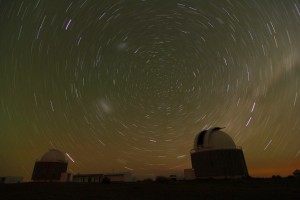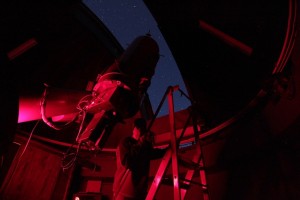Last night I sat alone, on the flattop remnant of an ancient volcanic intrusion, it’s hardened crust resisting erosion moreso than the surrounding terrain. This is where the telescopes reside, spaceships that travel millions of light years but never leave the launching pad.
I sat on a folded blanket, three layers on top, two on the bottom. The air was perfectly still, the sky dark overhead. I read the latest novel by sci-fi master Ben Bova while pressing the shutter on my camera, via remote, over 200 times. Each exposure was 20 seconds long, capturing the SALT observatory silhouetted against the centre of the galaxy.
Satisfied I had captured enough for a timelapse animation, I repacked my camera, book, water, nuts, and blanket and walked along the paved road to the observatory which houses the 20″ telescope on which I have been training. Pierre was conducting his observation run, and doing research into which objects we might photograph the following night.
The moon was rising when I departed, visiting the two astronomers in the 1.9m observatory. Danika, a Ph.D. student from Serbia training under her professor from Australia.
I had left my camera running, a long exposure at low ISO to capture star trails behind the SALT observatory.
Ever time I step into an observatory dome, I am overcome with a sense of childhood thrill, the kind that Jae and I likely shared when we built a fort in our shared bedroom, made of card tables and blankets and flash lights, or when as a child I first visited NASA JPL and saw the Galileo spacecraft under construction.
For me, the observatory has this kind of mind-expanding capacity, for it reaches to the night sky and receives photons from distant galaxies each with billions of stars, massive explosions closer to home, and of the stuff that gives foundation to the formation of planets which may be home to inquisitive creatures looking back at us.
The telescopes are tremendous achievements of engineering and design. There is an incredible sense of accomplishment when you one move, a 3-story, multi-ton creature of iron, steel, and glass as graceful as a dancer; as accurate as a laser.
Like astronauts, the astronomers reside in a small, cramped quarters monitoring the light received by the telescope just outside. Following each observation, one rises, slips through the door which isolates the telescope from their heat and light, to adjust the direction the instrument is pointing.
Returning to their seat, warm cup of tea or coffee or hot chocolate, the music, conversation, and observation resume.
Night after night, week after week, across the planet, thousands of individuals dedicate their sleepless hours to gathering data which helps us better understand our world.


